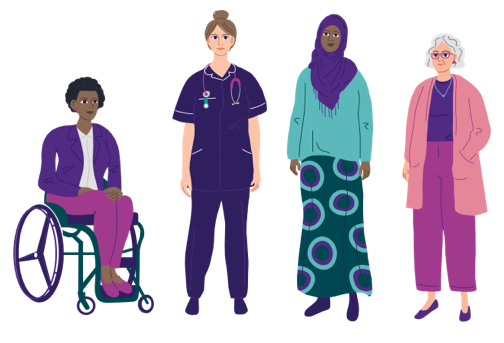The British Gynaecological Cancer Society, Ovarian Cancer Action and Target Ovarian Cancer, in partnership with the National Cancer Registration and Analysis Service (NCRAS), are funding a joint project: the ovarian cancer audit feasibility pilot. This project will map ovarian cancer care, surgery and survival across the NHS in England for the first time.
If you would like to discuss any of the issues raised by the audit, please call our support line.
Postcode lottery in diagnosis
The ovarian cancer audit feasibility pilot’s first findings were published in January 2020 and revealed that:
- Women in some parts of England are twice as likely to be diagnosed with ovarian cancer than in other areas. This is after age is taken into account – ovarian cancer is more common in women over 50. There are a number of likely reasons behind this, including ethnicity, birth rates and take-up of the contraceptive pill.
- There's significant variation in the number of women diagnosed at an early stage (stage I and II) when the disease is most treatable and chances of long term survival are greatest.
- At the moment, just 33 per cent of women with ovarian cancer are diagnosed at stage I and II and 50 per cent with stage III and IV.
- Worryingly, in some places data was missing for more than one in four women with an ovarian cancer diagnosis.
Differences in treatment
The ovarian cancer audit feasibility pilot’s most recent findings were published in November 2020 and showed significant regional access to ovarian cancer treatment (particularly surgery) across England. They revealed that:
- Four in ten women with ovarian cancer across England didn't receive surgery. This is despite surgery being the treatment which offers the best long-term prognosis for women with the disease.
- One in five women diagnosed received no ovarian cancer treatment at all.
- For older women, access to treatments drops with 37 per cent above the age of 70 not receiving any treatment, rising to over 60 per cent for those aged 80 and over.
The findings also showed the probability of women with a diagnosis receiving any treatment for their cancer varies significantly by area in England. This is even after taking into account factors that might explain differences in local treatment practices – such as the age of the patients treated and how advanced their cancer was.
Whilst the link between treatments given and outcomes wasn’t investigated, the findings showed that areas of the country where women with ovarian cancer were more likely to receive treatment generally had higher survival rates. The relationship between access to treatment and survival may be particularly pronounced for surgery – a key treatment option for women with ovarian cancer.
More research is needed to establish the reasons why survival rates for ovarian cancer are higher in some areas than others, and how far regional differences in treatment are responsible.
Next steps
It's hoped the ovarian cancer audit feasibility pilot results in a regular audit of ovarian cancer to drive improvements in clinical practice as well as providing a model that can be rolled out across other cancers. This pilot is currently running in England; the long-term aspiration is to see audits take place across all four UK nations.
Read more about all of the ovarian cancer audit's findings so far.


